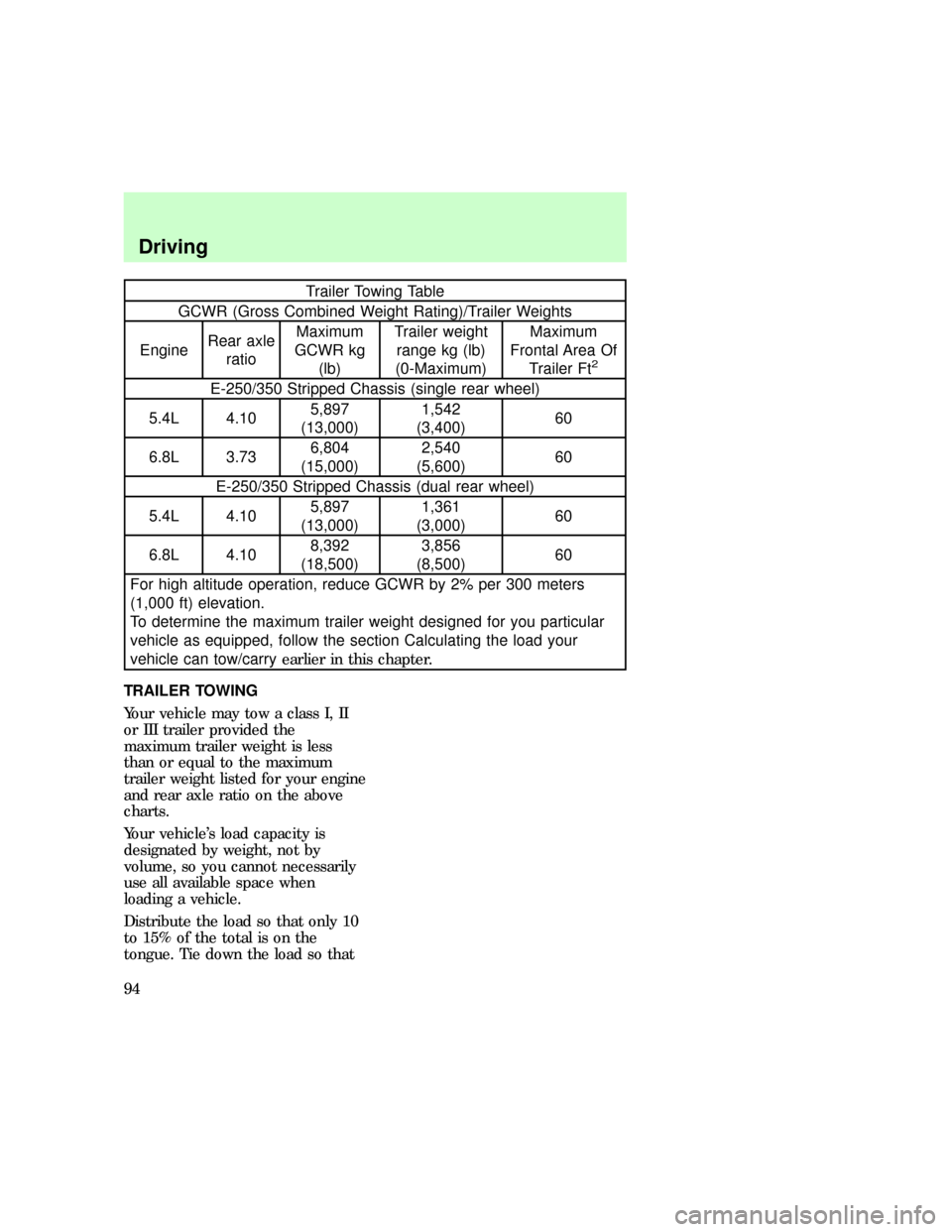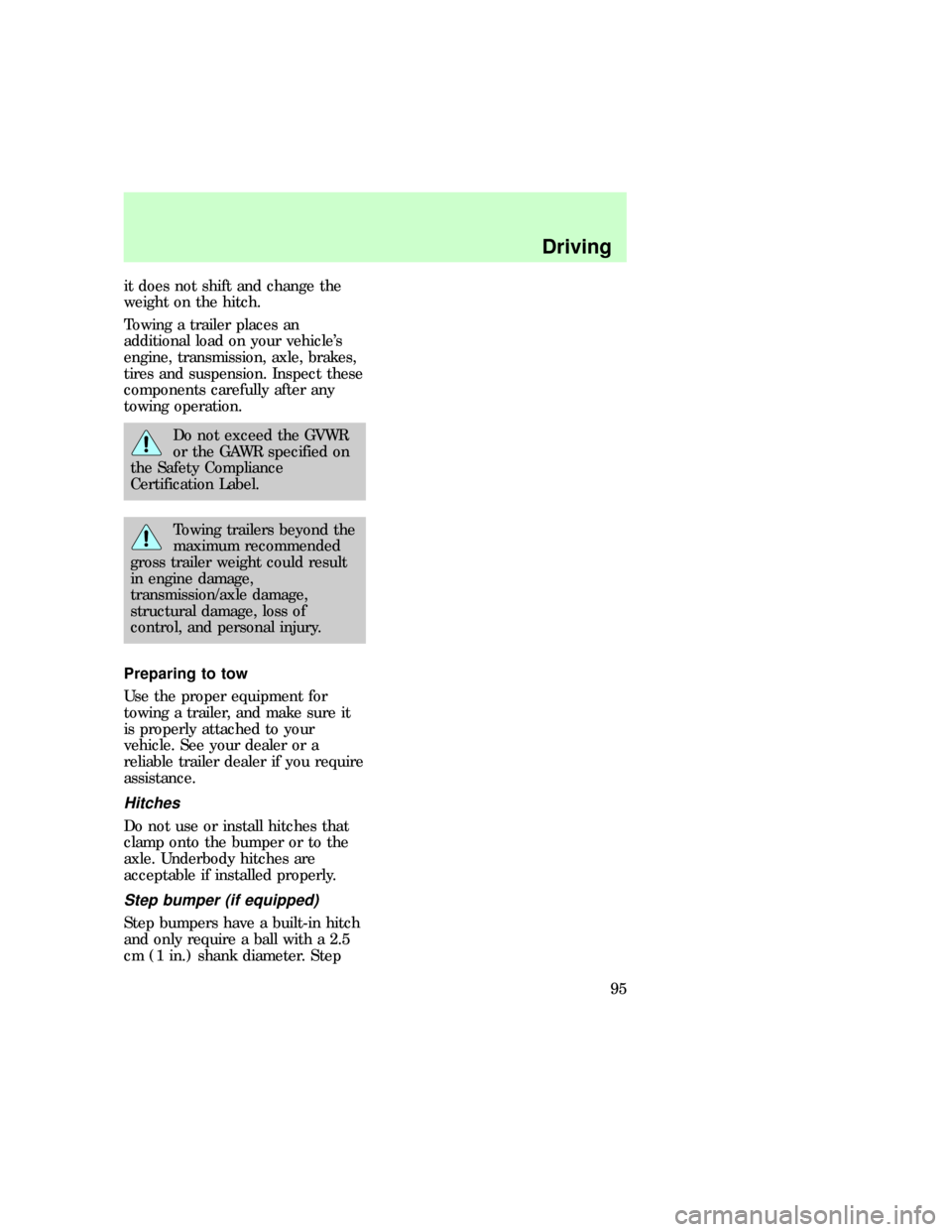Page 94 of 192

Trailer Towing Table
GCWR (Gross Combined Weight Rating)/Trailer Weights
EngineRear axle
ratioMaximum
GCWR kg
(lb)Trailer weight
range kg (lb)
(0-Maximum)Maximum
Frontal Area Of
Trailer Ft
2
E-250/350 Stripped Chassis (single rear wheel)
5.4L 4.105,897
(13,000)1,542
(3,400)60
6.8L 3.736,804
(15,000)2,540
(5,600)60
E-250/350 Stripped Chassis (dual rear wheel)
5.4L 4.105,897
(13,000)1,361
(3,000)60
6.8L 4.108,392
(18,500)3,856
(8,500)60
For high altitude operation, reduce GCWR by 2% per 300 meters
(1,000 ft) elevation.
To determine the maximum trailer weight designed for you particular
vehicle as equipped, follow the section Calculating the load your
vehicle can tow/carryearlier in this chapter.
TRAILER TOWING
Your vehicle may tow a class I, II
or III trailer provided the
maximum trailer weight is less
than or equal to the maximum
trailer weight listed for your engine
and rear axle ratio on the above
charts.
Your vehicle's load capacity is
designated by weight, not by
volume, so you cannot necessarily
use all available space when
loading a vehicle.
Distribute the load so that only 10
to 15% of the total is on the
tongue. Tie down the load so that
eco_trailer
Driving
94
Page 95 of 192

it does not shift and change the
weight on the hitch.
Towing a trailer places an
additional load on your vehicle's
engine, transmission, axle, brakes,
tires and suspension. Inspect these
components carefully after any
towing operation.
Do not exceed the GVWR
or the GAWR specified on
the Safety Compliance
Certification Label.
Towing trailers beyond the
maximum recommended
gross trailer weight could result
in engine damage,
transmission/axle damage,
structural damage, loss of
control, and personal injury.
Preparing to tow
Use the proper equipment for
towing a trailer, and make sure it
is properly attached to your
vehicle. See your dealer or a
reliable trailer dealer if you require
assistance.
Hitches
Do not use or install hitches that
clamp onto the bumper or to the
axle. Underbody hitches are
acceptable if installed properly.
Step bumper (if equipped)
Step bumpers have a built-in hitch
and only require a ball with a 2.5
cm (1 in.) shank diameter. Step
eco_preparing_tow
eco_hitch
eco_step-bumper
Driving
95
Page 96 of 192
![FORD E SERIES 1997 4.G Owners Manual bumpers have a Class III capability
(2,270 kg [5,000 lb] trailer weight
and 227 kg [500 lb] tongue weight.
Safety chains
Always use safety chains between
your vehicle and trailer. Cross
chains under t FORD E SERIES 1997 4.G Owners Manual bumpers have a Class III capability
(2,270 kg [5,000 lb] trailer weight
and 227 kg [500 lb] tongue weight.
Safety chains
Always use safety chains between
your vehicle and trailer. Cross
chains under t](/manual-img/11/4790/w960_4790-95.png)
bumpers have a Class III capability
(2,270 kg [5,000 lb] trailer weight
and 227 kg [500 lb] tongue weight.
Safety chains
Always use safety chains between
your vehicle and trailer. Cross
chains under the trailer tongue and
allow slack for turning corners.
Connect safety chains to the
vehicle frame or hook retainers.
Never attach chains to the bumper.
Trailer brakes
Trailer brakes are required on
most towed vehicles weighing over
680 kg (1,500 lbs)
Do not connect a trailer's
hydraulic brake system
directly to your vehicle's brake
system. Your vehicle may not
have enough braking power and
your chances of having a
collision greatly increase.
Trailer lamps
Trailer lamps are required on most
towed vehicles. Make sure your
trailer lamps conform to Federal
and local regulations. See your
dealer or trailer rental agency for
the proper instructions and
equipment for hooking up trailer
lamps.
Driving while you tow
Do not drive faster than 88 km/h
(55 mph) while towing a trailer. Do
not drive faster than 72 km/h (45
mph) with a trailer while towing in
eco_safety_chains
eco_trailer_brakes
eco_trailer_lamps
eco_driving_towing
Driving
96
Page 97 of 192

hilly country or on hot days.
Speed control may shut off if you
are towing on very long, steep
grades.
When towing a trailer
If towing a trailer and your vehicle
is not equipped with the Ford
trailer tow package, an auxiliary
transmission fluid cooler is
recommended.
²Use D (Drive) rather than
D(Overdrive) while towing up
or down steep hills. This will
eliminate excessive downshifting
and upshifting for optimum fuel
economy and transmission
cooling.
²Anticipate stops and brake
gradually.
²Allow more room for stopping
with a trailer attached.
²Practice turning, stopping and
backing in an area before
starting on a trip to get the feel
of the vehicle/trailer
combination.
²When turning, drive slightly
beyond the normal turning point
so the trailer wheels will clear
curbs and other obstacles.
²When stopped in traffic for long
periods of time in hot weather,
place the gearshift in P (Park)
to increase idle speed. This aids
engine cooling and air
conditioner efficiency.
²Vehicles with trailers should not
be parked on a grade. If you
eco_when_towing
Driving
97
Page 98 of 192
must park on a grade, place
wheel chocks under the trailer's
wheels.
²After you have travelled about
80 km (50 miles), thoroughly
check your hitch, electrical
connections and trailer wheel
lug nuts.
Launching or retrieving a boat
When backing down a ramp during
boat launching or retrieval,
²Do not allow the static water
level to rise above the bottom
edge of the rear bumper and
²Do not allow waves to break
higher than 15 cm (six inches)
above the bottom edge of the
rear bumper.
Exceeding these limits may allow
water to enter critical vehicle
components, adversely affecting
driveability, emissions and
reliability.
Servicing when towing
If you tow a trailer for long
distances, your vehicle will require
more frequent service intervals.
Follow the severe duty
maintenance schedule outlined in
the ªService Guide.º
com_launch-retrieving_boat.01
eco_service_when_towing
com_fuel_consumption.01
Driving
98
Page 122 of 192
Do not connect the end of
the second cable to the
negative ([-]) terminal of the
battery to be jumped. A spark
may cause an explosion of the
gases that surround the battery.
Jump starting
1. Start the booster vehicle and
run the engine at moderately
increased speed.
2. Start the engine of the vehicle
with the discharged battery.
3. Once the engine has been
started, run both vehicles for a
further three minutes before
disconnecting the leads.
Removing the jumper cables
1. Remove the jumper cables in
reverse order. Take the cable off
the metallic surface (1) first,
followed by the cable on the
negative (-) booster battery
terminal (2).
2. Remove the cable from the
positive (+) terminal of the booster
battery (3) and then the
discharged battery (4).
3. After the disabled vehicle has
been started, allow it to idle for a
while so the engine can ªrelearnº
its idle conditions.
+–
+–
2
3
4
1
com_jump_starting.01
com_removing_cables.01
eco_wrecker_towing
Roadside emergencies
122
Page 123 of 192
WRECKER TOWING
The recommended method to tow
your vehicle is with flatbed or
wheel lift equipment. However,
slingbelt towing is acceptable. On
vehicles equipped with an air dam,
the towbar will deform the rubber
air dam.
Never use a tow bar that
attaches to the bumper
when you tow your vehicle. This
could damage the bumper and
cause an accident.
Roadside emergencies
123
Page 133 of 192
Adding engine oil
1. Check the engine oil. For
instructions, refer toChecking the
engine oilin this chapter.
2. If the fluid level is not within
the normal range, add only
certified engine oil of the preferred
viscosity. Add engine oil through
the oil filler cap. Remove the filler
cap and use a funnel to pour oil in
the opening.
3. Recheck the oil level. Make sure
the oil level is not above the full
mark on the dipstick.
Continuous contact with
usedmotor oil has caused
cancer in laboratory mice.
Changing the engine oil and
filter
Change your engine oil and filter
according to the following
kilometers (mileage) and time
requirements, whichever occurs
first:
²Normal Schedule ± 8,000 km
(5,000 miles) or six months.
²Severe Duty Schedule ± 5,000
km (3,000 miles) or three
months. Severe duty operation
would include extensive idling,
trailer towing, driving in severe
dust and police, taxi or delivery
service.
com_oil_and_filter_change.01
Maintenance and care
133